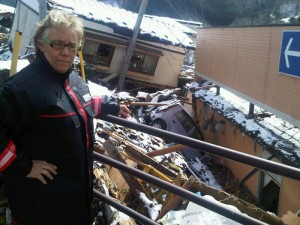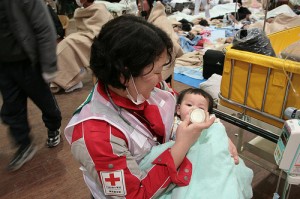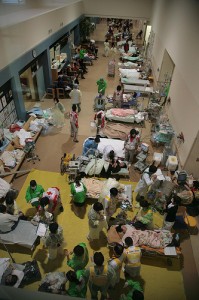 |
U.S. Coast Guard Capt. (ret.) Richard Fremont-Smith,
a life-long Red Cross volunteer, poses in his home
office holding a picture of him with former
Red Cross President Elizabeth Dole. |
Unlike many retirees, 76 year old Richard Fremont-Smith isn’t shuffle-board playing, rocking-chair material. This retired Coast Guard captain still enjoys being active and loves his Fort Lauderdale waterfront house with the boat docked in back.
Fremont-Smith had a successful career as a Coast Guard officer, stockbroker and hospital administrator, but a significant point of pride is his 50-year commitment to the American Red Cross as a volunteer and benefactor.
Born in Boston, Fremont-Smith grew up a block away from the Greater Boston Chapter, American Red Cross. In 1952 at the age of 17, he took his first CPR/First Aid course and never looked back. Shortly after the CPR class, Fremont-Smith signed up for the Disaster Action Team – a group of highly trained volunteers who help people affected by house fires and other disasters.
He soon found himself in the heart of such major events as the Worcester, Mass., tornado of 1953 – a rare New England tornado that killed more than 90 people – and hurricanes Donna, Carol and Edna in New England in the 1950s. In the midst of these devastating disasters, Fremont-Smith and the Red Cross took care of those in need.
“We provided the victims with food, drink, shelter and emotional support,” said Fremont-Smith. “I remember being 17 and 18 and driving the disaster truck to remote areas to distribute good food, hot coffee and other assistance.”
During the summer of his sophomore year at Harvard, 19 year-old Fremont-Smith donned the Red Cross vest again, but this time as the Greater Boston Red Cross interim disaster director. He supervised the DAT members and recalled the collision of the Italian ocean liner the SS Andrea Doria that happened during his internship: “Forty-six people were killed that day and many survivors were brought to Boston. We did our best give them the assistance they needed.”
He went on many fire and other emergency calls and helped those affected. “At the time there was really no other assistance available and the people were very appreciative,” he said. “I may have spent more time with the Red Cross than I did studying.”
In 1956, after completing his sophomore year, Fremont-Smith enlisted in the U.S. Coast Guard. During his initial 10-year career with the Coast Guard, then Lieutenant Fremont-Smith traveled the world and was stationed in the Philippines and in Vietnam in 1965-1966 during the war.
In 1966, after a year of Vietnam combat duty, Fremont-Smith left the Coast Guard, went to Columbia University and got his MBA degree. After a brief stint as a stockbroker, he pursued his new interest in hospital administration. He also reconnected with the Red Cross and served on the board of directors of the Greater Boston Chapter.
He had remained in the Coast Guard Reserve, and in 1982, the Coast Guard called him back as a Captain to serve on a special assignment in Washington, D.C. What was slated to be a four-month project turned into a 12-year assignment, eight years of it at the Pentagon. But the Red Cross was never too far behind. In 1989 Hurricane Hugo ravaged the Virgin Islands and the Red Cross disaster relief operation needed Fremont-Smith’s help. The Coast Guard and the Pentagon granted Fremont-Smith a six-week leave to serve as Red Cross Government Liaison Officer at St. Croix, USVI.
“We were feeding and sheltering 20,000 people. As government liaison, I coordinated everything between the Red Cross, government officials and local emergency agencies,” explained Fremont-Smith. “It was extremely active, busy and exciting.”
In 1994, Fremont-Smith retired from the Coast Guard and moved to Fort Lauderdale. But again, the Red Cross was never too far behind. He soon became involved with the local Red Cross chapter and served as a government liaison officer and mass care volunteer, and later as a member of the board.
“Throughout my career, I’ve always been interested in emergency work and public safety,” said Fremont-Smith. “I keep returning to the Red Cross because it does a great job in providing relief for people who have been affected by disaster. I enjoy being around to help others. I am very empathetic of the victims of disaster.”
The son of a renowned Boston physician father, and a highly acclaimed tennis player and author mother, Fremont-Smith comes from a lineage of helping others. After WWI, his father, Maurice Fremont-Smith, M.D., volunteered with the Near East Relief and the Red Cross in Turkey helping survivors of the war.
Over the span of 50 years, Dick volunteered in over 100 disaster relief operations across the country and U.S. territories and touched the lives of tens of thousands of people.
When Fremont-Smith listed some of the disaster relief operations he participated in, he sounded like a disaster field operations manual: “Wildfires in California, tornadoes in Oklahoma, an airplane collision outside Los Angeles, hurricanes, floods and the Value Jet airplane crash in the South Florida everglades” just to name a few.
For years, Fremont-Smith gave generously of his time and talent, but he was also generous with his treasure. When asked for one of his fondest Red Cross moments he recalls his meeting with then American Red Cross President Elizabeth Dole in 1987. Fremont-Smith had donated $25,000 to the Broward County Chapter and was invited, along with other donors, to Washington, D.C. for a meet-and-greet and dinner with Dole. “I had a wonderful time and Mrs. Dole was lovely.”
Fremont-Smith no longer goes out on fire calls or to disaster stricken areas, but he remains involved and has taken steps to ensure that the Red Cross can continue its humanitarian mission after his volunteer days are over.
“I decided to include the American Red Cross in my estate plan through a bequest. The concept of neighbors helping neighbors is an old one, but one that truly works as Red Cross volunteers and employees across the country can attest,” explained Fremont-Smith. “I respect the Red Cross and it’s important to me that they have the financial resources needed to continue doing the good work they do everyday,” stated Fremont-Smith.
For more information on including the American Red Cross in your estate plan please call Gloria Kaplan, Sr. Gift Planning Officer at 1-800-759-2050 or email kaplang@usa.redcross.org. Contributions to the American Red Cross, a tax-exempt organization under section 501 (c) 3 of the Internal Revenue Code, are tax deductible. Federal Tax ID # 53-0196605.










 Donate Today
Donate Today




